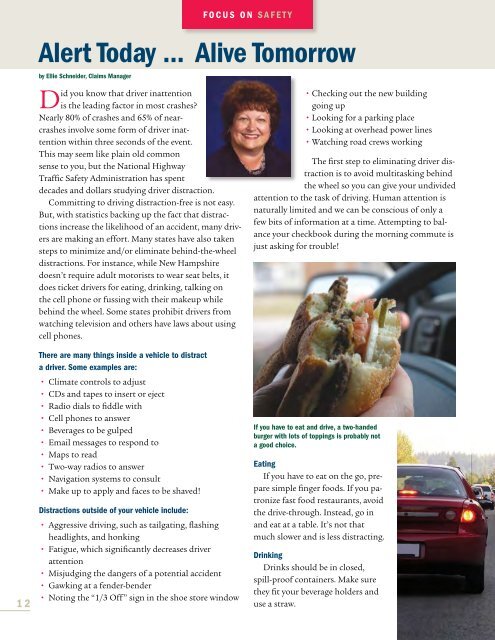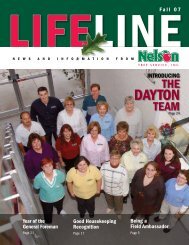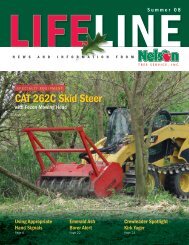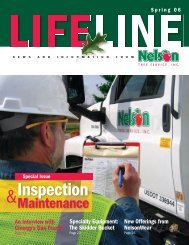LIFELINE
Winter 08 - Nelson Tree Service
Winter 08 - Nelson Tree Service
Create successful ePaper yourself
Turn your PDF publications into a flip-book with our unique Google optimized e-Paper software.
Alert Today ... Alive Tomorrow<br />
by Ellie Schneider, Claims Manager<br />
Did you know that driver inattention<br />
is the leading factor in most crashes?<br />
Nearly 80% of crashes and 65% of nearcrashes<br />
involve some form of driver inattention<br />
within three seconds of the event.<br />
This may seem like plain old common<br />
sense to you, but the National Highway<br />
Traffic Safety Administration has spent<br />
decades and dollars studying driver distraction.<br />
Committing to driving distraction-free is not easy.<br />
But, with statistics backing up the fact that distractions<br />
increase the likelihood of an accident, many drivers<br />
are making an effort. Many states have also taken<br />
steps to minimize and/or eliminate behind-the-wheel<br />
distractions. For instance, while New Hampshire<br />
doesn’t require adult motorists to wear seat belts, it<br />
does ticket drivers for eating, drinking, talking on<br />
the cell phone or fussing with their makeup while<br />
behind the wheel. Some states prohibit drivers from<br />
watching television and others have laws about using<br />
cell phones.<br />
F O C U S O N S A F E T Y<br />
• Checking out the new building<br />
going up<br />
• Looking for a parking place<br />
• Looking at overhead power lines<br />
• Watching road crews working<br />
The first step to eliminating driver distraction<br />
is to avoid multitasking behind<br />
the wheel so you can give your undivided<br />
attention to the task of driving. Human attention is<br />
naturally limited and we can be conscious of only a<br />
few bits of information at a time. Attempting to balance<br />
your checkbook during the morning commute is<br />
just asking for trouble!<br />
1 2<br />
There are many things inside a vehicle to distract<br />
a driver. Some examples are:<br />
• Climate controls to adjust<br />
• CDs and tapes to insert or eject<br />
• Radio dials to fiddle with<br />
• Cell phones to answer<br />
• Beverages to be gulped<br />
• Email messages to respond to<br />
• Maps to read<br />
• Two-way radios to answer<br />
• Navigation systems to consult<br />
• Make up to apply and faces to be shaved!<br />
Distractions outside of your vehicle include:<br />
• Aggressive driving, such as tailgating, flashing<br />
headlights, and honking<br />
• Fatigue, which significantly decreases driver<br />
attention<br />
• Misjudging the dangers of a potential accident<br />
• Gawking at a fender-bender<br />
• Noting the “1/3 Off” sign in the shoe store window<br />
If you have to eat and drive, a two-handed<br />
burger with lots of toppings is probably not<br />
a good choice.<br />
Eating<br />
If you have to eat on the go, prepare<br />
simple finger foods. If you patronize<br />
fast food restaurants, avoid<br />
the drive-through. Instead, go in<br />
and eat at a table. It’s not that<br />
much slower and is less distracting.<br />
Drinking<br />
Drinks should be in closed,<br />
spill-proof containers. Make sure<br />
they fit your beverage holders and<br />
use a straw.








